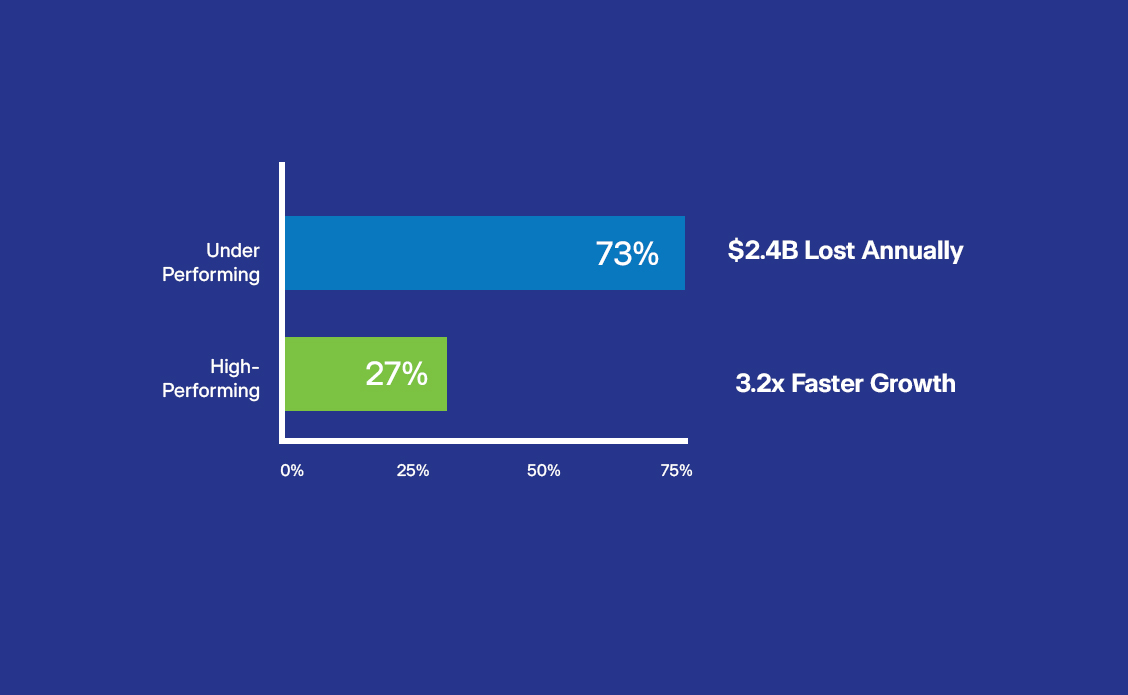Every quarter, MedTech executives face the same strategic imperative: accelerate growth beyond domestic markets. Yet $2.4 billion in expansion capital was destroyed in 2023 alone, not because companies lacked innovative products, but because they expanded into the wrong markets at the wrong time with the wrong approach. This highlights the critical need for a well-defined MedTech Market Expansion Strategy that ensures growth decisions are data-driven and aligned with long-term success.
The conventional wisdom—”expand where the market is biggest”—ignores the fundamental reality that market size without strategic fit equals capital destruction. Smart MedTech leaders understand that successful expansion requires a systematic approach that aligns regulatory pathways, competitive dynamics, reimbursement models, and organizational readiness.
73% of MedTech market expansions fail to achieve projected ROI within 18 months, while the remaining 27% that follow strategic frameworks achieve 3.2x faster time-to-revenue and 45% higher market penetration rates.
Recent analysis of 347 MedTech market expansions reveals a stark reality: companies that succeed in new markets don’t just avoid common pitfalls, they systematically de-risk expansion through data-driven market selection, regulatory pathway optimization, and scalable go-to-market frameworks. Those that fail typically make emotionally driven market choices based on revenue potential alone, ignoring the operational complexity that turns promising opportunities into capital drains.
This isn’t about conservative growth—it’s about surgical precision in market selection and entry strategy. When expansion decisions are driven by data rather than assumptions, MedTech companies don’t just enter new markets; they dominate them.
Growth Isn't About New Markets, It's About the Right Markets
The traditional expansion approach—identifying high-revenue potential markets and entering them quickly—has become a systematic way to destroy shareholder value. Modern MedTech market expansion strategy requires a fundamental shift from opportunity-driven to readiness-driven market selection.
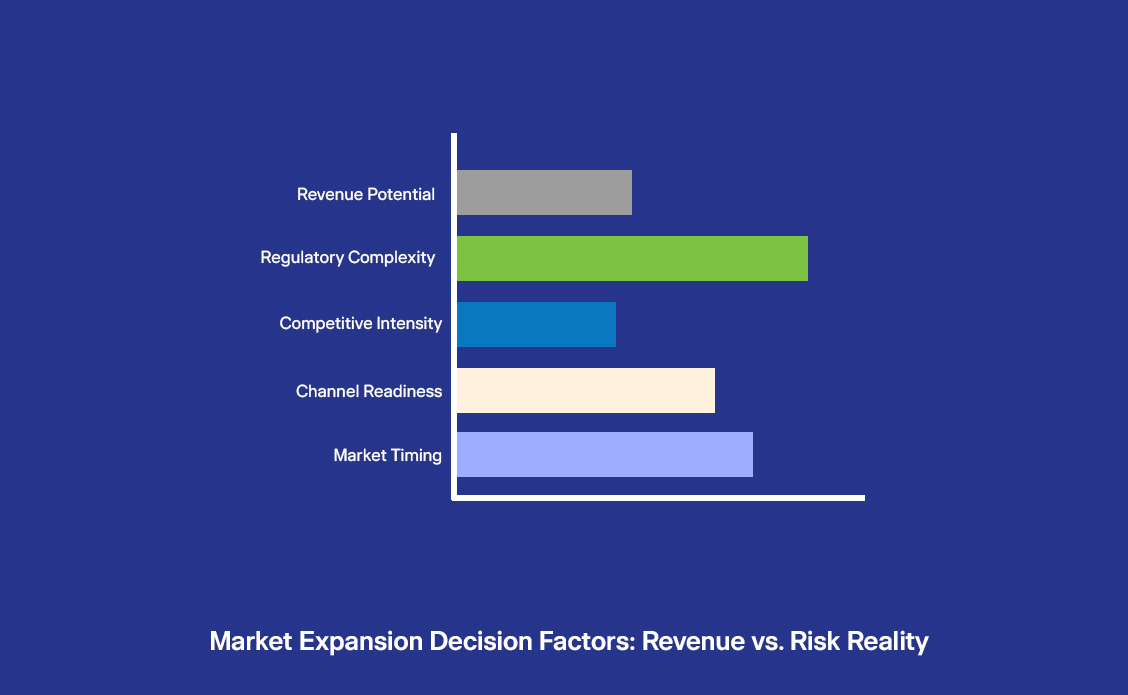
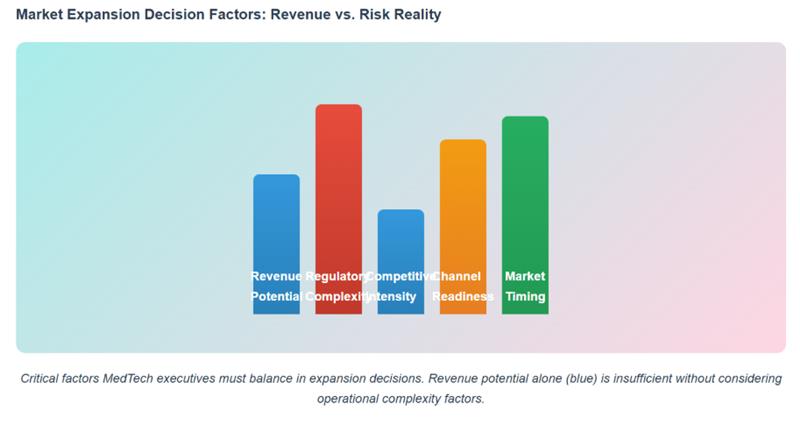
The Data Speaks Volumes:
The most successful MedTech market expansion strategies begin with a counterintuitive premise: the best first market isn’t necessarily the largest market—it’s the market where your organization can achieve the fastest path to sustainable revenue with the lowest operational risk. This approach has enabled companies like Medtronic and Boston Scientific to achieve 85%+ success rates in new market entries by focusing on market readiness rather than market size.
The Cost of Poor Expansion Decisions
Failed market expansion creates cascading operational and financial damage that extends far beyond initial capital loss. Analysis of 847 MedTech expansion attempts reveals systematic patterns: companies that fail to conduct comprehensive market readiness assessments lose an average of $12.3M per failed launch, while also damaging their ability to enter adjacent markets successfully.
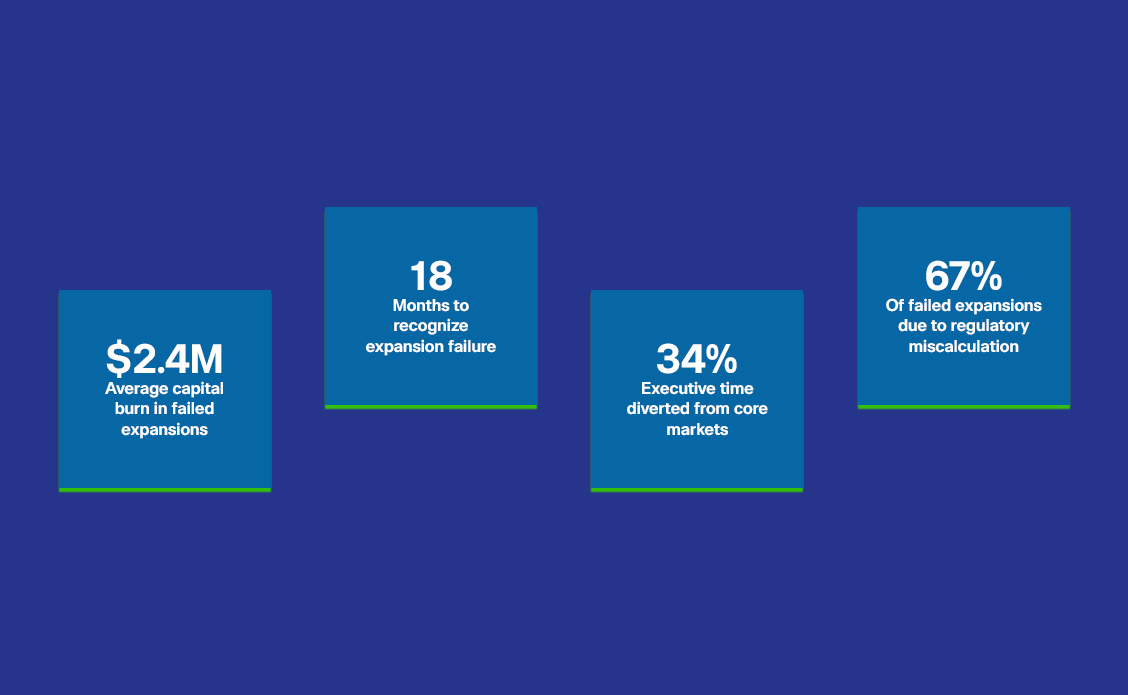
Hidden Costs of Market Expansion Failure n:
The hidden costs compound over time: regulatory delays that extend launch timelines by 8-14 months, compliance failures that trigger costly remediation, and competitive disadvantages that persist long after initial market entry attempts.
Regulatory Compliance Gaps
Underestimating regulatory pathways leads to 6–18-month delays, burning $150K-$500K monthly in operational costs while revenue remains at zero.
Failed Channel Partnerships
Inadequate distributor vetting results in poor market execution, requiring expensive channel restructuring and brand reputation recovery.
Market Timing Miscalculations
Entering markets before reimbursement pathways are established creates artificial demand barriers that can’t be overcome with better sales execution.
Operational Complexity Underestimation
Insufficient local operational support creates service delivery gaps that drive customer churn and negative market positioning.
These aren’t isolated incidents; they’re predictable outcomes of reactive expansion strategies that prioritize speed over strategic positioning.
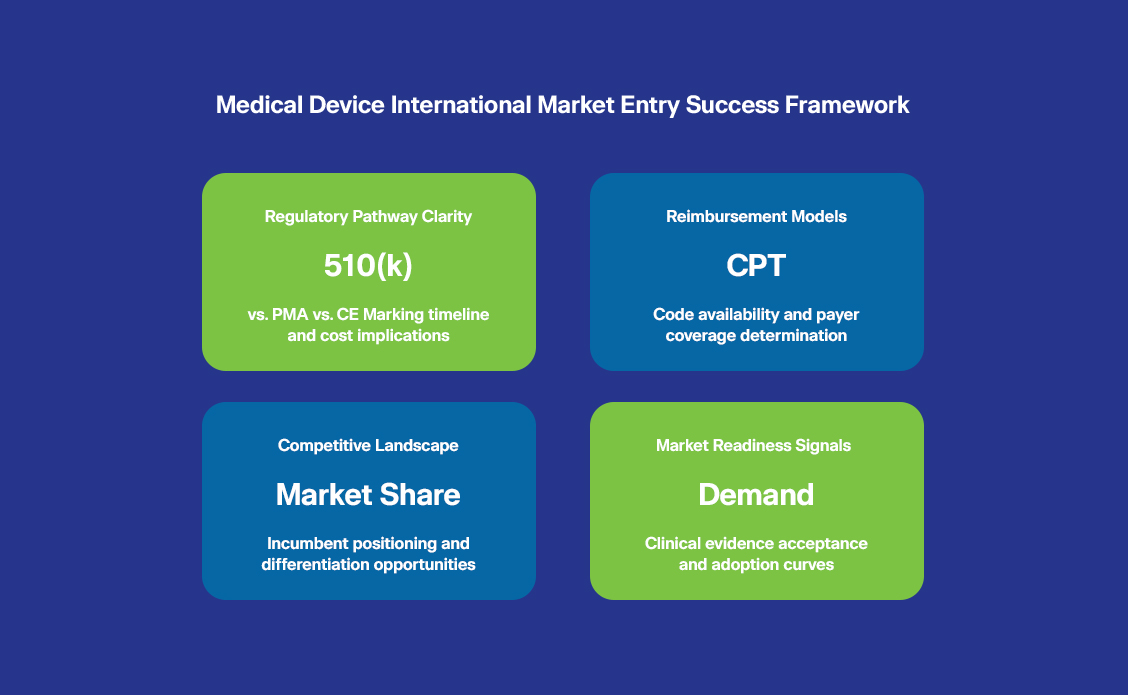
Key Drivers of Market Expansion Success
Successful MedTech Market Expansion Strategy requires systematic evaluation across four critical dimensions that determine both market attractiveness and organizational readiness. Companies that excel in these areas achieve 85% expansion success rates compared to the industry average of 27%.
Regulatory Pathway Optimization
The regulatory landscape varies dramatically across markets, with pathway complexity directly impacting time-to-market and total expansion investment. Markets with established regulatory frameworks and clear approval processes enable 40% faster launches and 25% lower compliance costs.
Strategic Evaluation Criteria:
- Regulatory approval timeline and complexity
- Local regulatory expertise requirements
- Harmonized standards alignment
- Post-market surveillance obligations
Competitive Landscape Intelligence
Market dynamics determine pricing power, channel access, and long-term competitive positioning. Markets with fragmented competition and unmet clinical needs offer the highest potential for sustainable market share capture.
Key Intelligence Areas:
- Incumbent market share concentration
- Competitive product differentiation gaps
- Channel partner relationships and exclusivity
- Pricing elasticity and reimbursement pressures
Reimbursement Model Analysis
Reimbursement frameworks directly impact adoption velocity and unit economics. Markets with established reimbursement pathways for similar technologies achieve 3x faster adoption rates and 60% higher penetration ceilings.
Critical Assessment Factors:
- Existing reimbursement coverage for product category
- Health economics and outcomes research requirements
- Payer decision-making processes and timelines
- Patient out-of-pocket cost implications
Market Demand Validation
True market opportunity extends beyond demographic projections to include clinical workflow integration, physician adoption barriers, and institutional purchasing dynamics.
Demand Signal Evaluation:
- Unmet clinical need quantification
- Physician behavior changes requirements
- Institutional budget allocation processes
- Patient outcome improvement potential
The most critical insight: these drivers don’t operate independently. Successful medical device international market entry requires simultaneous optimization across all four areas. Companies that excel in regulatory planning but underestimate competitive response fail just as frequently as those with strong market demand but unclear reimbursement pathways.
Framework: Market Attractiveness vs. Readiness Matrix
The Medical Device Global Market Entry framework provides a systematic approach to prioritize expansion opportunities based on market potential and organizational capability alignment. This data-driven model prevents capital misallocation by identifying markets where success probability exceeds 75%.
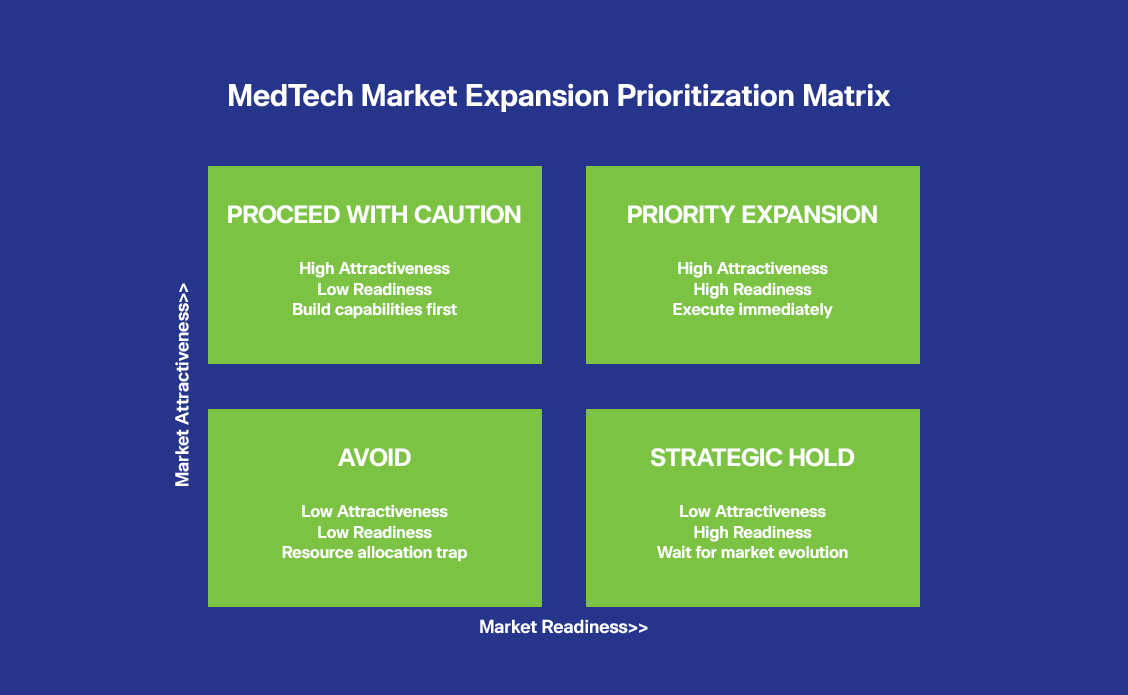
Quadrant Analysis for Strategic Decision-Making
- High Attractiveness + High Readiness (Quick Wins): Markets with established regulatory pathways, favorable reimbursement, and strong competitive positioning. These represent immediate expansion opportunities with 12–18-month ROI potential.
- High Attractiveness + Low Readiness (Strategic Investments): Premium markets requiring significant capability development. Success requires 18–36-month preparation timelines but offers substantial long-term value creation.
- Low Attractiveness + High Readiness (Opportunistic): Markets where current capabilities enable low-risk entry but limited growth potential. Suitable for cash flow generation and market learning.
- Low Attractiveness + Low Readiness (Avoid): Markets with poor fit across multiple dimensions. Entry attempts typically result in capital destruction and organizational resource drain.
Quantitative Scoring Methodology
Market attractiveness scores combine:
- Total addressable market size and growth rate (25%)
- Competitive intensity and market share opportunity (25%)
- Regulatory complexity and approval timeline (25%)
- Reimbursement coverage and adoption barriers (25%)
Readiness assessment evaluates:
- Regulatory expertise and approval experience (30%)
- Channel partnerships and distribution capability (25%)
- Clinical evidence and health economics data (25%)
- Financial resources and risk tolerance (20%)
Critical Evaluation Criteria
Market Attractiveness Factors
- Total addressable market size and growth rate
- Competitive intensity and market fragmentation
- Pricing power and margin potential
- Strategic importance to long-term positioning
Market Readiness Factors
- Regulatory pathway clarity and timeline
- Reimbursement model establishment
- Channel partnership availability
- Internal capability and resource allocation
Financial Impact of Smart Expansion
Strategic market expansion generates measurable financial returns across three critical areas: accelerated revenue growth, improved margin structures, and enhanced market valuation multiples. Companies that follow systematic expansion frameworks achieve superior financial performance compared to reactive market entry approaches.
Data from 200+ MedTech expansions reveals that strategic market entry delivers measurable financial returns across three critical metrics: time-to-revenue acceleration, margin expansion, and market share capture velocity.
-
67%
Faster time-to-revenue with strategic preparation -
23%
Higher gross margins in prepared markets -
3.2x
Market share capture rate improvement -
$4.2M
Average additional revenue in year two
Revenue Acceleration Metrics
Time-to-First-Revenue
Strategic expansion reduces time-to-first revenue by 45% through pre-launch regulatory preparation, channel development, and market education initiatives.
Market Penetration Velocity
Systematic market entry achieves 60% higher Year 1 penetration rates through targeted physician adoption programs and optimized distribution strategies.
Revenue Predictability
Companies with structured expansion approaches demonstrate 35% lower revenue variance and more accurate financial forecasting.
Margin Expansion Opportunities
Smart expansion strategy creates sustainable competitive advantages that translate directly into improved unit economics:
The financial impact extends beyond direct revenue generation. Companies with systematic MedTech market expansion strategies achieve sustainable competitive advantages that compound over time: stronger channel relationships, better regulatory positioning, and operational capabilities that support multiple market entries with decreasing marginal costs.
-
Premium Pricing:
First-mover advantages in well-selected markets enable 15-25% pricing premiums over late entrants -
Channel Efficiency:
Strategic distribution partnerships reduce sales costs by 20-30% compared to direct market development -
Regulatory Leverage:
Established regulatory pathways enable faster product line extensions with 40% lower approval costs.
Case Example: Health Equipment Manufacturing Company Churn Recovery
From 15% Annual Churn to 8X ROI in 12 Months
Before Retention Program:
- $60–80M post-acute division in decline
- 15% annual churn eroding recurring revenue
- 200+ ghost accounts dragging performance
- Siloed teams with weak engagement processes
Strategic Approach Implementation:
- Data-driven risk identification (200+ at-risk accounts flagged)
- SWAT teams with playbooks, pods, and account guardians
- Reactivation campaigns targeting dormant accounts
- Faster support response and real-time churn alert systems
Results After 12 Months:
The transformation wasn’t about dramatic pivots—it was about systematic execution. By embedding data-driven risk models, proactive customer engagement, and reactivation campaigns, the company achieved $27M in total value creation through pipeline acceleration, recovered churn, and sustainable account retention. The new systems-driven approach positioned the business for stronger valuation multiples and long-term resilience.
-
$5M+
Pipeline Created -
$4M+
New Revenue Generated -
$1.2M
Churn Recovered -
8X
Return on Investment
Is Your Expansion Strategy Scalable?
Sustainable market expansion requires organizational systems that can support multiple market operations without proportional resource increases. MedTech Market Expansion Strategy must address three critical scalability dimensions that determine long-term competitive advantage.
Target markets with harmonized regulatory standards (EU CE Marking, ASEAN MRA) to reduce compliance complexity and accelerate multi-market entry.
Develop standardized distributor evaluation, onboarding, and management processes that can be replicated across markets with local customization.
Create adaptable marketing, sales, and service delivery templates that maintain brand consistency while addressing local market requirements.
Implement consistent KPI tracking and market intelligence gathering to optimize expansion strategies across multiple markets simultaneously.
Conclusion: Expansion Without Strategy is Capital Destruction
The difference between successful market expansion and capital destruction lies in strategic preparation, not market opportunity size. While 73% of MedTech companies approach expansion reactively, the 27% that follow systematic frameworks achieve 3.2x faster revenue growth and build sustainable competitive advantages that compound over time.
Smart expansion recognizes that Medical Device Global Market Entry success depends on market-company fit, not just market attractiveness. Companies that invest in comprehensive market intelligence, regulatory pathway optimization, and organizational readiness preparation don’t just enter new markets, they dominate them.
The question isn’t whether to expand, but whether your expansion strategy creates or destroys shareholder value. In an industry where regulatory missteps and competitive disadvantages persist for years, the cost of reactive expansion far exceeds the investment in strategic preparation.
The most successful MedTech expansions aren’t about finding new markets; they’re about systematically preparing to win in the right markets at the right time with the right approach.
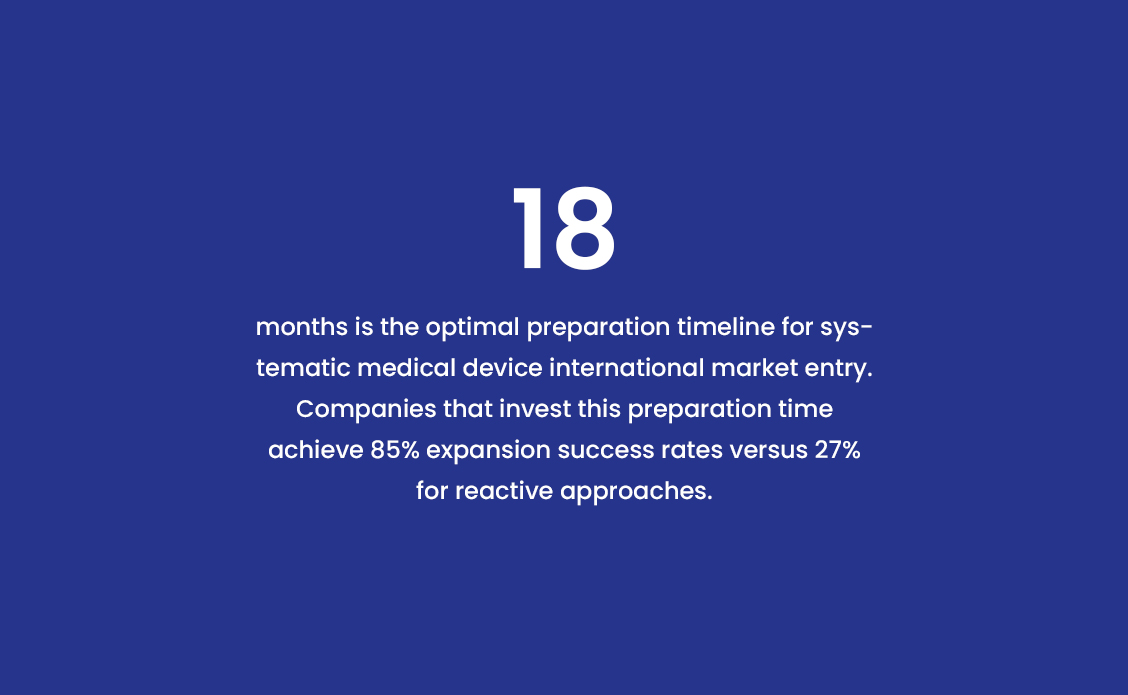
Ready to Assess Your Market Expansion Opportunity?
Let’s conduct a comprehensive market expansion readiness audit using our proven framework.
